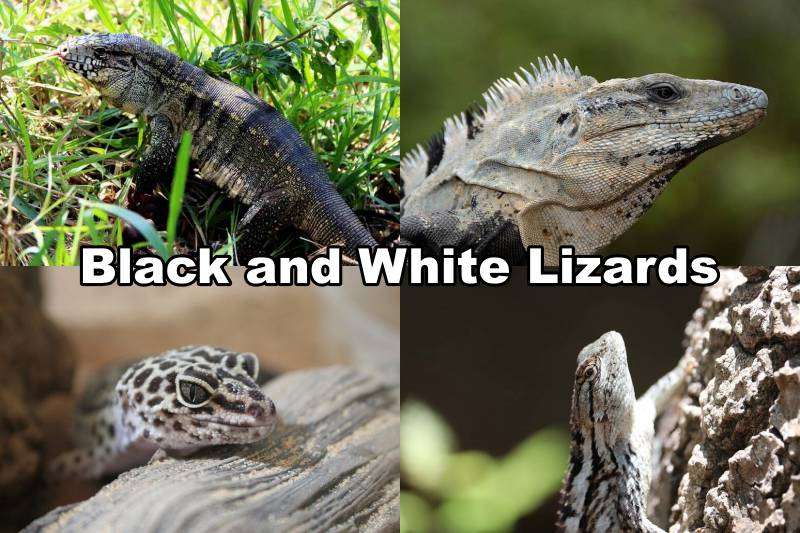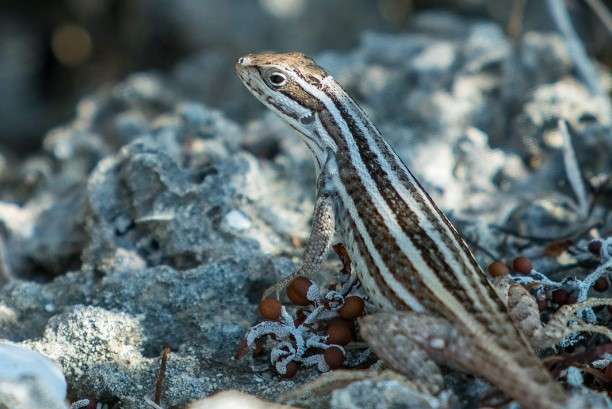When it comes to color on the skin of a lizard, black and white are two very common. The colors sometimes make up the whole hue scheme, and sometimes there are more vivid and distinct colors in the mix. Today, we’ll be talking about those lizards that have black and white on them and making a list of the black and white lizards.
In this article, we’ve discussed ten black and white lizards in a brief while listing the rest. Here are 15 black and white lizards.
List of 15 Black and White Lizards
1) Argentine Black and White Tegu

Our list of black and white lizards begins with the Argentine Black and White Tegu. The primary color scheme and the distribution of this species are quite clear by its very name.
They are natives of Argentina and South American countries. These lizards are known for being intelligent and able to be domesticated. That is why they have popularity among humans as pets.
As very apparent from their name, the whole body of the Argentine black and white tegu is black and white. They are quite large in size, with stout, thick bodies.
The base color is white, marked by stark black patterns all over. The markings on the ventral side are less congested and appear as splotches. The tegus have conical faces and long, bifurcated tongues.
- Common Name: Argentine Giant Tegu, Black and White Tegu, Huge Tegu
- Scientific name: Salvator merianae
- Size: males- 120 – 140 centimeters (4 – 4.5 feet)
- Location: Argentina, Brazil, Paraguay, Uruguay
2) Common Dotted Garden Skink
The Common Dotted Garden Skink is a species of nonvenomous lizard found in some countries of Southeast Asia. They prefer to live in hilly regions. This skink species has a bright red tail during its juvenile period but loses its color in adulthood.
Like most skinks, common dotted garden skinks are small and slender with tiny limbs. The base color of the body ranges from cream to pale yellow to white.
The body, from head to tail, has several stripes on the dorsal side. Each stripe is made up of several tiny black dots, which are the characters behind their common name.
The dots extend to the limbs and start at the head from a point. The ventral side is complete with the base color. As adults, the skin colors darken to become more muted shades.
- Common Name: Common Snake Skink, Punctate Supple Skink, Spotted Supple Skink
- Scientific name: Riopa punctata
- Size: 35 – 96 millimeters (snout-to-vent length)
- Location: India, Bangladesh, Nepal, Pakistan, Vietnam, Sri Lanka
3) Axanthic Halmahera Blue-Tongued Skink
Halmahera Blue-Tongued Skink is a subspecies of the Indonesian Blue-Tongued Skink. These lizards are endemic to Halmahera Island and its nearby areas in Indonesian territory. They also have the skinniest tail out of all the subspecies of Tiliqua gigas.
The original color of the Halmahera Blue-Tongued Skink is black with a cream base color with some orange on the back. There’s a genetic mutation in the subspecies, which causes a lack of yellow and other pigmentations.
Specimens with this mutation are called axanthic. Axanthic Halmahera blue-tongued skink has white as the base color with black patterns all over the body.
The limbs of these snakes are completely black, while the underside of the face is totally white. The head has some black markings, but those end before the eyes.
- Scientific name: Tiliqua gigas gigas
- Size: 46-61 centimeters (18-24 inches)
- Location: Halmahera Island, Classic Indonesian, Sorong, Aru, Jayapura, Manokwari and Ambon of Indonesia
4) Black Spiny-Tailed Iguana
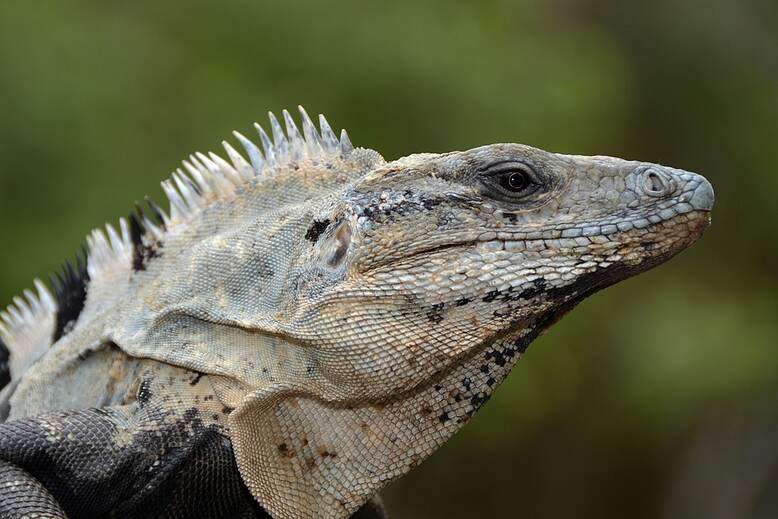
Black Spiny-Tailed Iguana is native to Central America and has also been introduced in Florida in the United States. This iguana has its name in the Guinness Book of World Records as the fastest lizard in the world.
Its maximum speed is 34.6 km/h. The lizard uses its speed to outrun its predators but can retaliate and bite when threatened.
Black spiny-tailed iguana has black, gray, and brown as the primary colors of their skin. The dorsal side is mostly gray with 3 – 4 black stripes in the middle; the face and the tail have no stripes.
The ventral side has more of a brown tint to it, with some black marks under the chin. There is a row of white spines, sometimes mixed with yellow, along the vertebra of the lizard. The spines are included in the black stripes.
- Common Name: Black Iguana
- Scientific name: Ctenosaura similis
- Size: males- 130 centimeters (4 feet 3 inch); females- 80 – 100 centimeters (2 feet 7 inch – 3 feet 3 inch)
- Location: Isthmus of Tehuantepec, Nicaragua, Panama, Honduras, Costa Rica, Colombia
5) Emma Gray’s Forest Lizard
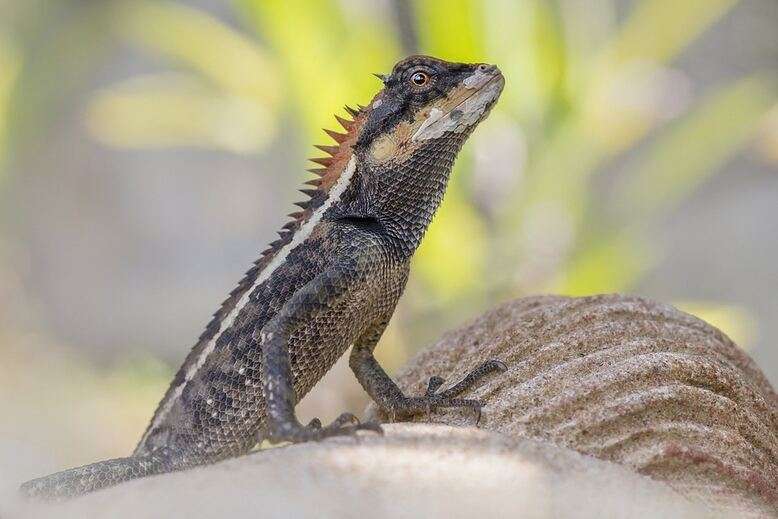
Emma Gray’s Forest Lizard is a nonvenomous and harmless lizard species endemic to the south and southeastern Asia. Its name is an honorary reference to Maria Emma Gray, an oncologist. She is the wife of John Edward Gray, a zoologist who described this species. Emma Gray’s forest lizard is often kept as a pet.
The most distinct part of their morphology is the three separate rows of spines on its head. The color of the spines matches that of the body.
The dorsal side is a mixture of black and brown, with two stripes of white running along the body on each side. The ventral side is tan or light brown. There is a pale yellow stripe along the mouth with some white coloration.
- Common Name: Forest Crested Lizard, Forest Garden Lizard
- Scientific name: Calotes emma
- Size: 28 – 40 centimeters (11 – 16 inches)
- Location: Bangladesh, Cambodia, China, India, Laos, Malaysia, Myanmar, Thailand, Vietnam
6) Great Basin Collared Lizard
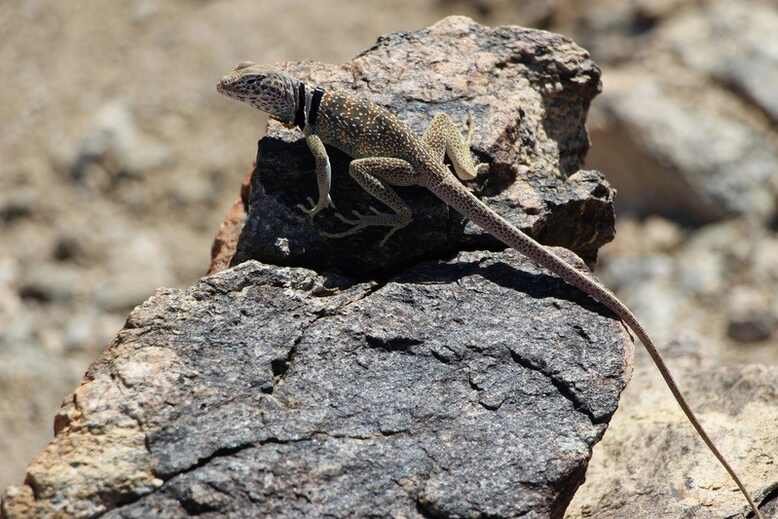
Number 6 on this list of black and white lizards is the Great Basin Collared Lizard. It is a species of small-sized lizard endemic to the Western United States.
The species is named after two thick, black bands and the white band in between them on the neck section of the lizard. The bands resemble a collar, leading to its name.
Males of this species are more colorful, with yellow, red, pink, and orange included in the color scheme. Females are more brown and black. The head and tail have white as a background color with brown spots.
The body is brown with alternate stripes of previously mentioned colors, most commonly yellow. The spots in this section are white.
- Common Name: Desert Collared Lizard, Mojave Black-Collared Lizard
- Scientific name: Crotaphytus bicinctores
- Size: 6.4 – 11.4 centimeters (2.5 – 4.5 inches)
- Location: California, Nevada, Oregon, Idaho, Utah, and Arizona of the United States
7) Texas Spiny Lizard

Texas Spiny Lizard is a species of nonvenomous lizard found in the south-central United States, including Texas and the northeastern states of Mexico.
These lizards show particularly interesting behavior when one male is challenged by another. In that case, the opponents start a push-up contest until one of them runs away.
The colors on the skin of the Texas spiny lizard include brown, black, white, and gray. These muted colors help the lizard camouflage in the dry environment they live in.
Sometimes there’s orange in the mix, acting as a splotch of color just below the neck. The ventral side of males has symmetrical blue patterns on both sides. The lizard also has characteristic spiny scales, which prompted the name of the species.
- Scientific name: Sceloporus olivaceus
- Size: 19 – 28 centimeters
- Location: the United States, Mexico
8) Oriental Garden Lizard
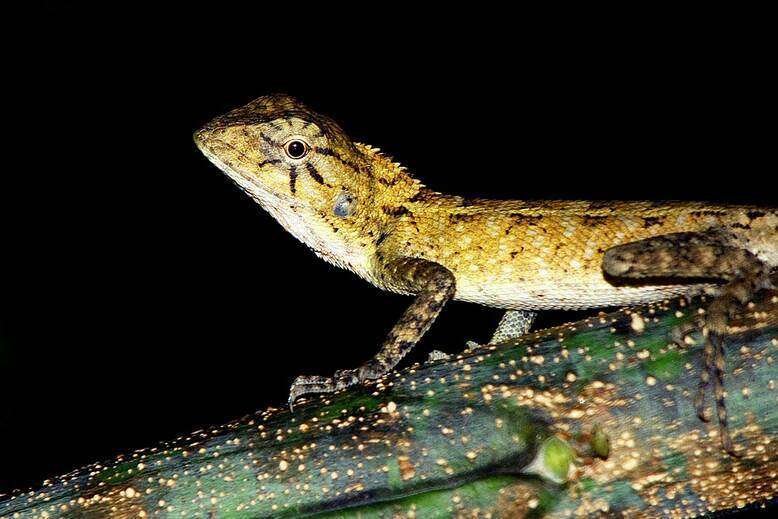
Oriental Garden Lizard is a species of lizard widespread around the Indo-Malaya region. It’s found in many countries in this region and has been introduced to some faraway places like the USA.
This species’ looks vary widely from its male to female members. The male lizards are more colorful than the females.
The colors found in male oriental garden lizards include orange, yellow, black, and pink. The females have more dull colors, like brown, grey, golden, and black. The ventral side of the female is completely white and without markings.
The dorsal side has yellow-grey as a base color with brown and white spots. There are several black markings around the eyes, patterned as if radiation from the source.
- Common Name: Eastern Garden Lizard, Indian Garden Lizard, Common Garden Lizard, Bloodsucker Lizard, Changeable Lizard
- Scientific name: Calotes versicolor
- Size: 37 centimeters (14.5 inches)
- Location: India, Iran, Afghanistan, Bangladesh, Bhutan, Cambodia, Indonesia, Malaysia, Maldives, Mauritius, Myanmar, Nepal, Pakistan, Philippines, Sri Lanka, Thailand, Vietnam, Brunei, Celebes, Oman, Seychelles, Singapore and the United States
9) Zebra-Tailed Lizard
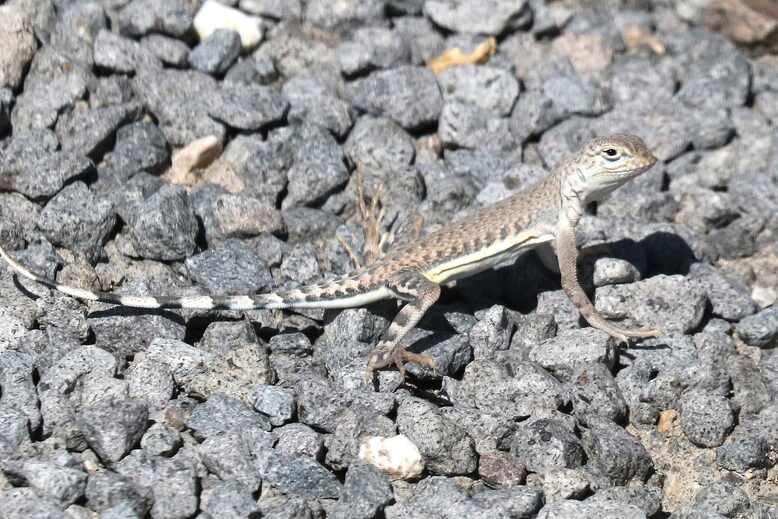
The Zebra-Tailed Lizard gets its name from the characteristic black and white stripes, similar to a zebra’s body, on its tail. The tail curls itself inward in an arch. This small, nonvenomous lizard shows a special behavior where it stands alternatively on each of its legs at the hottest time of the day.
The rest of the body of this lizard is tan and sandy brown, which turns a deeper brown around the edges. There are also brown markings towards the end of the body that become black crossbands around the tail.
The ventral side of the body is yellow, with occasional orange near the neck and chest. The portion under its mouth is white.
- Scientific name: Callisaurus draconoides
- Size: 64 – 102 millimeters (2.5 – 4 inches)
- Location: Southwestern United States, northwestern Mexico
10) Leopard Gecko

We’re at number ten on the list of black and white lizards, and the spot belongs to the Leopard Gecko. The species consists of small-sized, harmless geckos whose appearance resembles a leopard.
They are very popular as pets and are thought to be the first domesticated species of lizards. Reptile breeders breed them to get different color morphs.
One of the popular color morphs of leopard geckos is black and white. The gecko originally had yellow skin with black dots on them, like leopards, and a white ventral side. In black and white geckos, the dorsal side is mostly white with some yellowish coloration and the same black dots.
- Common Name: Common Leopard Gecko
- Scientific name: Eublepharis macularius
- Size: males- 20 – 28 centimeters (8 – 11 inches); females- 18 – 20 centimeters (7.1 – 7.9 inches)
- Location: India, Iran, Afghanistan, Pakistan, Nepal
11) Eastern Six-lined Race Runner
Let’s end this list with a common black-and-white lizard, the Eastern Six-lined Race Runner. It is called six-lined because it has yellow or green-yellow stripes that vertically extend down the body from head to tail.
Its body is dark brown or black in color with a white underside. Siz-lined Race Runners are diurnal means they carry out most of their activities during day time.
They are insectivores and feed mostly on grasshoppers and small spiders. They can easily be found in a variety of habitats, including grasslands, woodlands, floodplains, or mountain areas.
- Common Name: Eastern Six-lined Race Runner
- Scientific name: Aspidoscelis sexlineatus
- Size: males- 15.2 – 24.1 cm (6 – 9.5 inches)
- Location: throughout Georgia and South Carolina
12) Black-and-white Worm Lizard
The black-and-white worm lizard, also known as speckled worm lizard or spotted worm lizard, is a fascinating reptile found in parts of South America.
With a long, cylindrical body and smooth scales, it resembles a giant earthworm at first glance. Its striking coloration, consisting of alternating black and white bands, aids in camouflage.
These elusive creatures spend most of their lives burrowing underground, emerging primarily at night to hunt for insects and small invertebrates.
The black-and-white worm lizard’s unique appearance and secretive nature make it an intriguing species worthy of study and conservation efforts.
- Common Name: speckled worm lizard or spotted worm lizard
- Scientific name: Amphisbaena fuliginosa
- Size: males- 30-45 centimeters (12–18 in).
- Location: northern South America
13) Black-and-white Savannah Monitor
The well-known Savannah monitor, a docile giant pet lizard is a unique species of monitor lizard with intricate patterns.
They are generally tolerant of handling and are not very active animals. Although they are a common household pet in the US, Savannahs don’t always do well in captivity. This lizard requires strict care to be healthy therefore, it’s not a pet for the novice reptile lover.
Do you know? The majority of a Savannah monitor’s life is spent in the sun, digging burrows in the ground, and hunting a range of small prey items, including insects, rodents, and small lizards.
- Common Name: Bosc’s monitor
- Scientific name: Varanus exanthematicus
- Size: males- Adults range in size from 2.5 to 3.5 feet
- Location: from the savannah or grasslands of sub-Saharan Africa.
14) Black-and-white Saint Croix ground lizard
Small and native reptile to the U.S. Virgin Islands, the St. Croix ground lizards rustle through the leaf litter on four tiny Caribbean islands, engaging in conflicts and foraging throughout the day. They live in blissful ignorance of the fact that they are among the rarest lizards in the world, more specifically, critically endangered.
They have a habit of eating virtually any prey item, such as little hermit crabs, berries, moths, ants, and amphipods.
Lastly, its look can be described as parallel longitudinal bands of light brown, white, and black. The undersides of the legs, throat, and chest are pinkish, and the belly is light gray with blue margins on either side.
There are also alternating blue and black bands on the tail. However, not much is known about this species’ reproductive biology.
Yet, the males have bulky heads with blue ornamentation on their sides, while the females have comparatively slender heads with creamy white, brown, and black coloring. These physical characteristics make the two sexes easily identifiable.
- Scientific name: Ameiva polops
- Size: males- 35 to 77 millimeters in snout-vent length
- Location: Protestant Cay, Green Cay, Ruth Cay, and Buck Island (U.S. Virgin Islands)
15) Puerto Rican ground lizard
Another ground lizard on the list, the common Puerto Rican ameiva is a species of lizard in the whiptail family.
A comparatively large lizard, Ameiva exsul, has males that can reach lengths of up to 85 cm (33 in).
This species’ color patterns differ greatly between individuals, populations, and islands. They did, however, make our list because they are primarily gray, black, or brown in hue, with large or little white dots running along their backs. Another characteristic feature is that all individuals have a white or blue-white stained stomach.
- Common Name: Common Puerto Rican ameiva or Puerto Rican ground lizard
- Scientific name: Ameiva exsul
- Size: males- Max. recorded male snout-to-vent length (SVL)= 7.9 in., and the max. recorded female SVL= 3.9 in.
- Location: Puerto Rico, U.S. Virgin Islands, and the British Virgin Islands
We’ll conclude this article on black and white lizards here. Let us know what you think of the article in our comment section. And while you’re at it, make sure to go check our other articles on jaw-dropping animal facts.
Frequently Asked Questions
Q1. What is a black and white lizard called?
Ans. The Argentine black and white tegu (Salvator merianae) is the most popularly known black and white lizard among all the others.
Q2. Are tegu lizards poisonous?
Ans. The Tegus pose no threat to humans, whether they are kept as pets or in the wild. Despite having two big venom glands, they merely use them for self-defense, and since the venom is not too strong, it imposes no threat to humans.
Q3. Are black and white tegus aggressive?
Ans. Tegus are not aggressive toward humans, although they will protect themselves if they feel a threat from you. They have quick reflexes and can snap their tails. Plus, they possess powerful jaws, keen teeth, and claws.
Q4. Are black and white tegus good pets?
Ans. Reptile pet ownership involves a lot of responsibility, so it is not a game for the novices. However, even for intermediate or skilled reptile handlers, tegus can make excellent pets. When given proper care and socialization, they typically develop into clever and non-aggressive adults.
Q5. What do black and white lizards eat?
Ans. They typically eat fruits, eggs, insects, and small animals like rodents and reptiles as part of their omnivorous diet.
Q6. What brings white lizards to the house?
Ans. Lizards love exposed food, which encourages them to breed in your house. And in case you don’t want it, just never leave leftover food lying around.
Q7. What are the two types of poisonous lizards?
Ans. There are just two types of lizards that are poisonous: the Mexican Beaded Lizard and the Gila Monster, aka Heloderma suspectum.
Q8. Do lizards see in black and white?
Ans. Reptiles have color vision. As tetrachromats, most reptiles have four different types of cones, whereas humans only have three: red, green, and blue. This implies that they see all that humans see, including the full rainbow.
Also Read:

Anjali Prasad, a B. Pharm. graduate who works as a content writer for HowItSee, is based in Delhi. Except for her, not many people take the typical road from healthcare to writing. Her love of writing stemmed from her involvement in the college literature society and her early journaling at the age of 7. Hence, the love of learning and the spirit of exploration are what drew her to this career. You can find her on common social media like Instagram.
